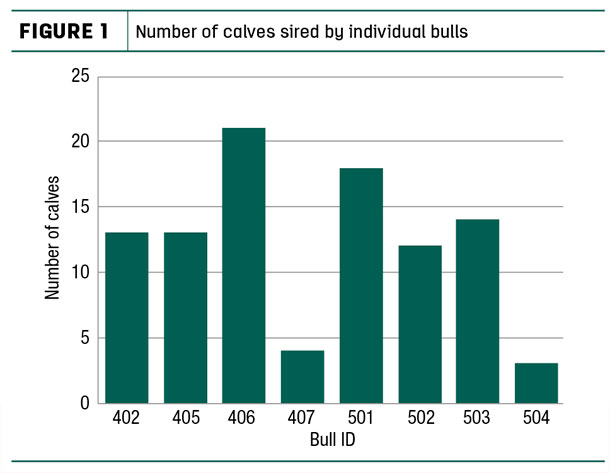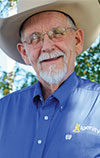Producers routinely have their bull battery evaluated prior to the breeding season by getting a veterinary assessment of physical conditions, semen quality and overall readiness for turnout with the cows.
Bulls are selected for their genetic potential to improve the cow herd, and it is economically important all bulls are fertile. Bulls that do not settle their share of cows early in the breeding season contribute to reproductive inefficiency and waste resources.
A breeding soundness exam (BSE) should be conducted on every bull between 30 and 60 days prior to each breeding season in order to allow time to replace questionable or unsatisfactory bulls.
A BSE includes the following:
-
Physical examination. The bull needs to be able to see, eat, smell and move around to successfully breed its share of cows.
-
Reproductive organs. A thorough examination of the bull’s reproductive system should follow. The spermatic cord, scrotum, testicles and epididymides need to be examined for evidence of abscesses, injury, frostbite damage or tumors.
The penis and sheath should be examined for any sores, lacerations, abscesses, scar tissue, hair rings, warts or adhesions.
-
Measurement of scrotal size. Scrotal circumference is a valuable indicator of semen production. Bulls with bigger testicles usually produce more semen and sire sons with bigger testicles. Scrotal circumference also is related to age of puberty.
- Evaluation of semen. Sperm cell concentration (number per cubic centimeter), motility (movement) and morphology (normal versus abnormal cells) are scored.
To be classified as an acceptable breeder requires a satisfactory physical examination and minimum values for scrotal circumference, motility and morphology.
Even though a bull may pass his BSE, there is no guarantee the bull has the libido to service cows. This is why collecting a DNA sample during the soundness exam is now being recommended. This will make it possible to add information about the bull’s breeding value (e.g., how many cows did each bull successfully breed?)
To obtain valuable insight from parentage testing, one first needs to get DNA on the bull battery. It’s practical and timely to do this during the BSE process. Bulls are already being handled. And early in the year, there is plenty of time to submit lab samples for parentage testing or DNA profiling.
It is not difficult, nor is it expensive to set up a sire DNA dataset for a ranch. But the knowledge that can be obtained will pay dividends. Producers can make many profitable decisions when they learn which bulls are performing up to expectations and which are not.
In Figure 1 is a dataset from a real production situation using yearling bulls in a multi-sire pasture.
 There was variation in the number of calves sired from the bulls, with No. 407 and No. 504 underperforming. Bulls like 407 and 504, siring three to four calves, are responsible for less revenue than the others siring 12 to 21 offspring.
There was variation in the number of calves sired from the bulls, with No. 407 and No. 504 underperforming. Bulls like 407 and 504, siring three to four calves, are responsible for less revenue than the others siring 12 to 21 offspring.
Producers often find great value in learning which animals in their bull battery are siring their best steer calves and replacement heifers by conducting parentage evaluation.
Along the way, they can identify which bulls are the cause of calving problems (dystocia), poor doers and congenital defects, and zero in on bull dominance, poor virility or genetic issues that reduce conception or pregnancy rates.
Understanding the genetic contributions of bulls is so key to return on investment. Parentage verification is the gateway for many producers who are making a first foray into genetic testing. So here is how to get the DNA collection done.
1. Sample bull DNA when you conduct BSE
This is a practical step to take when your veterinarian is doing BSEs or during other handling times. Allflex tissue-sampling units are a practical in-field option. These take mere seconds to collect and provide a clean, high-quality DNA sample that is easily stored (see video at Allflex tissue-sampling).
While the veterinarian is evaluating the bull, step in, collect a tissue sample from the ear, record the bull ID with the tissue-sampling unit sample number, and the job is done. No air-drying of samples. No difficulty or cross-contamination while collecting blood or hair and no undue delays while the bull is confined.
2. Submit bull DNA to lab
Send the bull tissue-sampling unit samples to the lab. Options are to order parentage, profiling or other DNA tests. Running a basic parentage test puts the bulls’ parentage DNA markers into a dataset the producer owns.
If by chance a producer does not have expected progeny differences on their bulls, they may wish to order a DNA profile on them. This also places the parentage DNA markers into their account plus provides genomic predictions for the bulls’ progeny. Items like horned/polled, coat color or other key traits also are options commonly requested at the same time a parentage test is ordered.
3. DNA the calves of interest
The same convenience of using tissue-sampling units for bulls is even better for DNA collection of heifer and steer calves. Sending in DNA samples for baby calves allows a producer to make early selection and management decisions. Using DNA parentage service verifying which calves come from which bulls is a major advantage.
Calves also can be DNA profiled, which includes parentage testing, for more information about their genetics.
Using a DNA profile to sort and select replacement heifers helps the producer make faster progress on management and marketing goals. But using parentage is often overlooked because bull DNA has not been collected in a timely fashion.
Commercial producers can get double duty from the BSE process by collecting bull DNA at that time. Progressive seedstock providers will conduct a BSE and genetic evaluation prior to sale, but every bull should be BSE checked every year.
It is a good idea to get the bull battery into a ranch parentage verification system. It only needs to be done once, and the advantages of using that data later can be significant. ![]()
John Paterson is also a professor emeritus from Montana State University with a Ph.D. in beef cattle nutrition.
PHOTO: Valuable insight can be given from obtaining DNA on the bull battery. Staff photo.

-
John Paterson
- Territory Manager
- Neogen GeneSeek
- Email John Paterson







